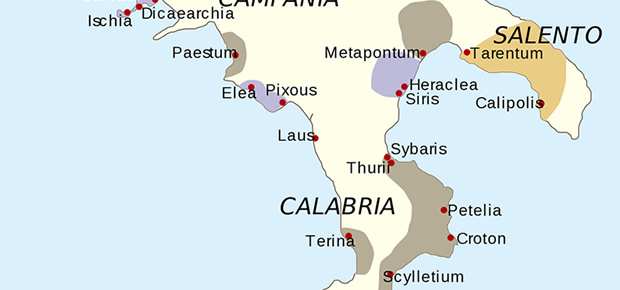
3.1 Peloponnesiache colonies on the Gulf of Taranto
In the same period in which it arose Syracuse, the Gulf of Taranto were founded other cities destined to become no less glorious, by settlers from various regions of the Peloponnese: dall'Acaia, from Laconia, dall'Argolide. This wave of migration, back a few decades to colonization in the West Euboian, landed on the coast of the Gulf of Taranto at the end of the eighth century. One after the other and side by side arose Sybaris, Crotone, Taranto, Metaponto.
Many were the Greek and Trojan heroes who, According to the legend, landed in Italy and Sicily, after the fall of Troy. Tra in which nostoi (returns) of these heroes were often interdependent relations, so much so that some could be collected in the same poem in five cantos, in an age indeterminable, composed of Agia Trezene, and entitled Nostoi, in the epic cycle that followed the Destruction of Ilium (Ilion Persia) Arctino ahead of Miletus and the Odyssey.
Strabone, before narrating how the Achaeans of the Peloponnese were settled in Metaponto shortly after the founding of Sybaris, tells us, without citing the source, that had existed before a Metaponto of Pili. This original Metaponto was founded by the companions of Nestor, the return of the Trojan War, and would have enjoyed such prosperity, thanks to the fertility of his campaign, that its inhabitants have dedicated at Delphi a "harvest gold". A proof of the existence of this city founded by Pili, Strabo adds that it was later destroyed by the Samnites. In particular, the Samnites quoted by Strabo, however, lies an anachronism since the invasion of the Samnites on the Ionian coast occurred only in the fifth century. We must therefore assume that Strabo has indicated with the term "Samnites" the natives, except that there is not even a confusion with the Samnites in the fourth century attacked the historical Metaponto. And maybe even the "golden harvest" consecrated at Delphi was an offer of much more recent Achaean colony, which in fact minted coins with the effigy of the ear. On the other hand Strabo clearly distinguished from the mythical founding of the historical Metaponto, and citing Antiochus, states that when the Achaeans Sibariti invited their brothers to settle in Metaponto, the region had already been abandoned by the first inhabitants. It should also be noted that the geographer Strabo, describing the coast of Etruria, says that the city of Pisa was a colony of Metaponto those same Pili who founded and was founded by the people of Pisa in the Peloponnesus, with that Nestor had participated in the Trojan War. On return from Troy, Pili these were lost and some of them settled on the Etruscan coast and part of Metaponto. At the origins of the Peloponnesian Etruscan Pisa also alludes to Virgil in the Aeneid, Virgil is completed and this news as well as Servius in his commentary on the Aeneid. This tradition is confirmed by Pliny the Elder. Also, Pisa was localized to the legend of Epeo, Homer's character who had participated in the Trojan War with thirty ships of the Cyclades and he had built with the help of Athena devised the wooden horse by Odysseus to take Troy, legend that is also found in the region metapontina.




